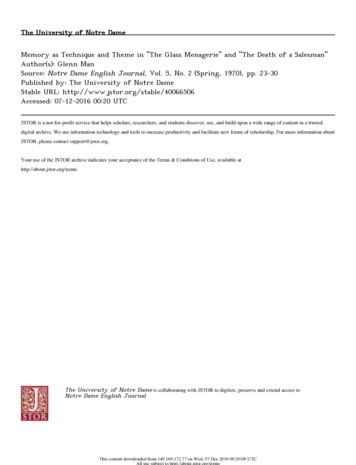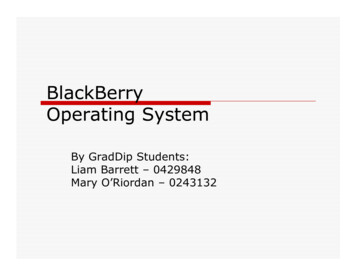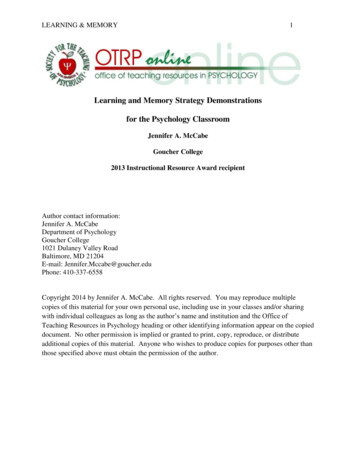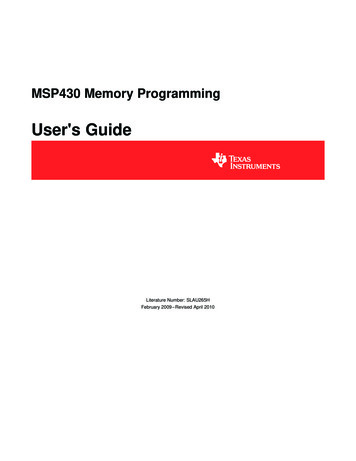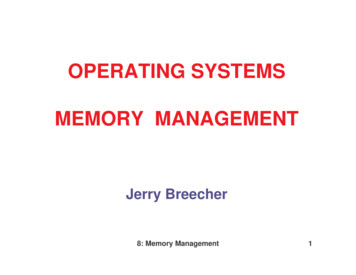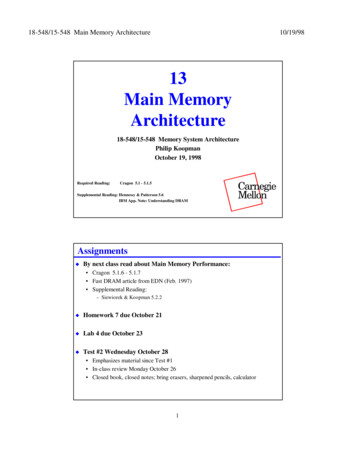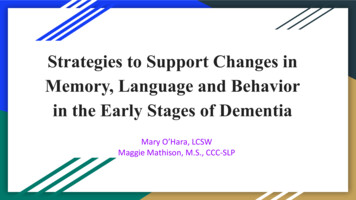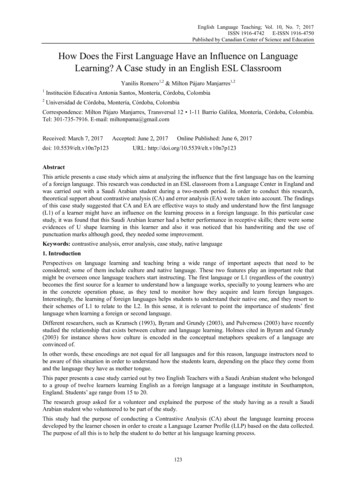
Transcription
Learning anotherlanguageA collection of articles on language learningfro m the Mempow ered w ebsiteBy Dr Fiona McPherson
Other article collectionsActive readingMnemonics at a glanceMemory in normal agingHelping your aging memoryMemory impairment in the aging brainBooks by Fiona McPhersonEffective Notetaking (Study Skills)Mnemonics for Study (Study Skills)Planning to Remember: How to remember what you’re doing and what you plan to doPerfect Memory TrainingThe Memory Key
ContentsApproaches to learning another language . 5Strategies for learning languages . 7Basic principles of learning . 11Mnemonics for learning languages . 13Gesturing . 14Gestures improve language learning . 14Gesturing to improve memory, language & thought . 16Writing things out . 19Better learning through handwriting . 19Foreign language better understood in your own accent . 20Literate Arabic speakers have bilingual brains . 20Relearning a forgotten language is easier for those under 40 . 24Why learning a new language may make you forget your old one . 21Effect of working memory capacity on new language learning . 21Are children really so much better at learning a second language? . 22Is timing important? . 24Language learning declines after second year of life. 24Learning a second language may not be as laborious as believed . 24Second language best taught in childhood . 25Study finds there's a critical time for learning all languages, including sign language . 25Music and language . 25Benefits of music training for language learning . 29
Benefits of bilingualism . 31Benefits in old age . 31Benefits for children . 34Neural substrate of second language learning . 37Anatomical advantage for second language learners . 37How bilingualism affects the brain . 37How does the bilingual brain distinguish between languages? . 38Fast language learners have more white matter in auditory region . 38Learning languages increases gray matter density. 39Both languages active in bilingual speakers . 39
Approaches to learning another languageHow many words do you need to learn?An analysis of English vocabulary* has found that the first 1000 words account for 84.3% of thewords used in conversation, 82.3% of the words encountered in fiction, 75.6% of the words innewspapers, and 73.5% of the words in academic texts. The second 1000 accounts for aboutanother 5% (specifically, 6% of conversation, 5.1% of fiction, 4.7% of newspapers, 4.6% ofacademic texts). In other words, if you learn the top 1000 words, you would understand 84% ofthe words used in ordinary conversation, and if you learned the top 2000, you would understand90% of the words used.While the effort to learn this second 1000 words may seem a lot of effort for not much gain, thedifference between understanding 84% of the words and understanding 90% is actually quitedramatic. Learn those first 2000, and you can go out there and talk to people, and the words youdon’t understand will be obvious by context a lot of the time.You will also have enough to read novels (87.4%) — not quite as good a coverage as inconversation, but good enough, especially when you consider the advantage a book has overconversation — you can take as long as you need to understand what’s being said.I haven’t seen such analyses in other languages, but I imagine that the results would be similar(perhaps even higher coverage given, since it is generally agreed that English has a particularlylarge vocabulary).I.S.P. Nation says, in his widely regarded text on learning vocabulary in another language1, that“high-frequency words are so important that anything that teachers and learners can do to makesure they are learned is worth doing.”In one sense, high-frequency words are easier to remember because you come across them sooften. But words are inherently different in how easily learned they are. What factors govern thelearnability of individual words?Factors that affect how easily learned a word isThe most important factor in determining how easily words are learned is, of course, how similarthey are to the words in one's native language (or another language you know well). Learning alanguage that is closely related to a language you already know is obviously a very differentproposition to learning a language that is unrelated. Thus, learning Spanish when you alreadyknow French and English and Latin (my own position) is made infinitely easier by virtue of thevast number of words that are "cognate" (words that are the same or very similar in bothlanguages).You do need to pay particular attention to so-called "false cognates" - words which appearsimilar, but have different meanings. But in most cases that doesn't require any special strategy;the observation that they are different is enough (provided, of course, that you are sufficiently
aware to remind yourself every time you come across the word - this is much easier if you areimmersing yourself in a language).Another factor is the similarity between the word and other words in the chosen language thatyou've already learned.Another factor is the context in which you are learning the word. You generally don't learn onlyone word at a time. So factors that will influence ease of learning will be: the relationship between the words (it's more difficult to remember words that are similarin meaning, if you try and learn them at the same time);how many words you're learning at a time (if the words are difficult, learn fewer);the order in which you learn them (words you learn first and last are more easilyremembered, therefore you need to give more attention to those in the middle, to make upfor it)What's your goal?Your strategy will also be very different depending on whether your primary goal is tounderstand the language (either in reading or listening) or to produce it (speaking or writing).Learning to speak or write is of course much more difficult than simply learning to understand(which requires recognition rather than the harder recall).Approaches to learning vocabularyYour approach to learning a language depends therefore on all these factors. Most particularly,how you learn a language depends on why you want to learn the language.A large proportion of teach-yourself language books assume your purpose is to travel in acountry that speaks that language. Accordingly, the emphasis is on learning appropriate phrasesfor situations such as eating in a restaurant, buying a train ticket, etc. Another, growing, sectionis aimed at business travelers, with appropriate phrases for formal introductions, conversations inan office, etc. Both of these categories emphasize the conversational — learning to speak andlisten.None of these, I'm afraid do anything for me. I’ve tried, but they are too far from what I want.Any time I spend on them is wasted by the little voice saying, ‘So? Do I care? Why should Iwant to know this?’ My own desire is always to be able to read the language.I was wildly delighted when I found "Literary Chinese by the inductive method" - a 1948 bookthat teaches Chinese by presenting the text of the simplest classic Chinese text - the Classic ofFilial Piety - and providing notes on the meaning of each character, including notes on thederivation of those characters and their elements. This method probably would not appeal tomany people, but since my primary reason for learning Chinese is to read the classic texts, itappeals to me hugely.
A large part of the appeal is that you are learning, right from the beginning, something "real".This is a text that people have been reading and studying for over 2000 years. That alone givesthe words an intrinsic fascination. And looking at each character through its etymology giveseach word a depth of meaning that immediately provides connections, and sometimes, emotionalresonance.For me, that is. I recognize that, for many people, this approach would leave them cold.The point is that, regardless of how "good" a course/book/program is, what matters is how well itworks for you. Which is why, even if you're using a "canned" system, you still need to customizeit to your own quirks and style. To do that you need to have a wide variety of strategies to callon, and an understanding of the principles involved.LinksGeneral resource for learning another languagehttp://www.languagetutoring.co.uk/Learning English:test yourself to find your level: http://www.er.uqam.ca/nobel/r21270/levels/learning words in english/news/words/general/word2001.shtml(news items with difficult words and phrases explained)http://www.rhymezone.com/ give it a word and it will find words that rhyme with it, and alsopoint to definitions, and quotations in which the word html exercises to improve your Englishhttp://www.comenius.com/idioms/ new idiom to assist students of English. They provide adefinition as well as audio files of the idiom itself and the idiom used in context.References:Nation, I.S.P. 2001. Learning Vocabulary in Another Language. Cambridge University Press.Strategies for learning languagesA general distinction you can make is that between: direct study, and
learning from contextDirect study is more important when you're learning a non-cognate language. It's also moreimportant in the initial stages of learning a language. Learning from context is particularly usefulfor cognate languages.Of course learning a language requires both approaches, but the relative proportions will vary.You need both definitional and contextual information to "know" a word properly. It is alsohelpful to process words at a "deeper" level - by playing with them, using them, thinking aboutthem.And of course, you need multiple exposures - a requirement for which extensive reading is thebest remedy, but in the beginning, is probably best answered by programmed texts/courses thatrepeatedly present words in slightly different contexts (e.g., in different sentences).Let's look at some particular techniques:Decontextualized vocabularyWord lists - can be a useful resource. generally decontextualized; however, sometimes they areprovided in conjunction with a reading passage, thus providing context - this is, of course, moreeffective. lists of "most frequently used" words can also be quite motivating. however, lists ofdifficult or less frequent words are probably more useful. lists are also fairly tedious to learnfrom. their main use is therefore as a resource - e.g., in order to make flashcards or semanticmaps. (look below for some word lists available on the Web)Set yourself targets (daily as well as longer term)Study words in their "families" - e.g., write, written, wrote, writing, typewriter, etcFlashcardsDrill - good for getting in the needed repetition; most useful when they involve multiple media;when they group words according to context (words that "belong" together, for one reason oranother), rather than, as is often the case, according to frequency; when they provide full andimmediate feedback. (More on flashcards below)Bilingual-dichotic methodThis is a somewhat specialized technique. Dichotic listening refers to a technique used in thepsychology laboratory, whereby a person wearing headphones hears different messages in theleft and right ear. The technique has been used with some success in teaching foreign languagewords - the foreign word is heard in the right ear while simultaneously the native translation isheard in the left ear (most people process speech better in the right ear). The student is instructed
to attend to the foreign language word. The student also has a list of the words to read whilelistening.ReadingGraded reading - is, after all, the means by which most of us acquired the bulk of our nativelanguage vocabulary; the main problem with this approach, when applied to another language, isthat you need to understand around 95% of the words in a text in order to infer the meaning ofthe rest. this makes it harder to simply grab books aimed at the native speaker - you need gradedreaders, specifically created for students of the language. another useful resource to build up yourvocabulary are bilingual readers.The great benefit of reading is the repeated experiences of the same words in slightly differentcontexts; the down side is that it is a time consuming method of learning. also, infrequent wordswill, of course, appear infrequently - these words really need to be given special attention.Dictionary use - using a bilingual dictionary is of course helpful, and often necessary; however,it is better if looking things up in the dictionary is NOT your first strategy - better to try andguess the meaning first. effective students tend to use a dictionary flexibly and thoughtfully; theyare also better at judging when guesses are likely to be accurate, and which words in a sentenceare most important for understanding the meaning.A useful strategy to prevent you getting too bogged down, is to mark the words you're in doubtabout, on your first reading, and then look them up at the end of the passage.The Web is a great resource for language students - find a newspaper in your chosen languageand practice with it regularly; find a radio station that broadcasts in your chosen languageI find DVDs wonderful - look for ones that offer your chosen language. You can listen in yournative language and have subtitles in your chosen language; listen to your chosen language withnative language subtitles; or, have both the soundtrack and the subtitles in your chosen language.RetellingTry to retell passages of text in your own wordsRecounting what you have learned to someone else is an excellent way to reinforce learning(trying to teach them is better still!)Remember to speak aloud words as you read/think themTalk to yourself - tell yourself what you're doing as you do it; make up sentences about what youcan see when you're walking, or waiting for somethingTry and think of different ways of saying the same thing
OrganizationHave a notebook to record new words and grammar points; don't simply list the words as youcome across them, but organize them into categories - categories that are personallymeaningful. for ready reference, start the notebook with a list of words you find or think you'llfind particularly difficult. (note: useful groups include generic categories, e.g., animals, fruit;functions, e.g., greetings, prepositions; situations, e.g., Post Office, airport, shop)Make labels for items round the home and stick them up - and don't limit yourself to singlewords, create sentences. remember to read them aloud at appropriate moments.In the bathroom and toilet, put up lists of declensions/conjugations or even passages of text ordialog.AssociationEven unrelated languages throw up words that share similarities - look out for these. Becreative.Physically act out words and sentences - use mime and gestures.Associate words with picturesVisualize wordsMnemonicsSee Mnemonics at a glance (downloadable document)ReviewPeriodic review - vital!To make sure words are "fixed", you need to overlearn them - don't tick them off too soon!Daily practice is essential, but try not to get into a rut. Routine is useful for establishing a habit,but ring the changes with your activities, both to keep your interest up, and because it is a moreeffective means of learning.Remember:Experiment with different strategies till you find what works for you.Aim to have a variety of strategies to choose from.
Some word listsEnglish top 1000 00 list1.htmI like this because it groups words according to their stem, thus: able: ability abler ablest ablyabilities unable inability:http://www.lextutor.ca/lists learn/1047 "basic" words in rench.html1040 "basic" words in erman.htmltop 1000 most-used German 01a.htmList of High-Frequency Baseword Vocabulary for Japanese EFL cabulary.htmlalso check out the supermemo language collections: http://www.supermemory.com/sml/language.htmBasic principles of learningWhen considering what will be the most effective strategies for you, don't forget the basicprinciples of memory:(1) Repetition repetition repetitionThe trick is to find a way of repeating that is interesting to you. This is partly governed by levelof difficulty (too easy is boring; too difficult is discouraging). The point is to find an activity(more than one, in fact), which enable you to hold on to your motivation through sufficientrepetitions to drive them into your head. Bear in mind, too, the importance of:(2) Changing contextSimple repetition (cat - el gato; cat - el gato; cat - el gato .) is not only boring, but also the leasteffective way of experiencing the needed repetition. Not only do you want to see/hear words
presented in a variety of different sentences; you also want to experience them in different ways listening, reading, speaking, writing.(3) Space your practice(4) Seek the linkThe basis for the keyword mnemonic, and the reason some words are "easy" and others not.Looking for the similarities between words, and being inventive when necessary, is crucial toeasing the learning burden, and reducing the number of repetitions you need to fix the word inyour memory. It can be as simple as observing that "gato" is very like "cat", or that "el borrego"means "sheep" because sheep are boring.FlashcardsFlashcards are cards with a word (or phrase) on one side and its translation on the other. You canbuy ready-made flashcards, and these can certainly be helpful, particularly if you'reinexperienced at learning another language. However, it is more effective if you make themyourself. Not only will the cards be customized to your own use, but the activity of selectingwords and writing them down help you learn them.A standard way of using flashcards is simply to go through a set number each day, separating outthose you have trouble with, so you can review them more often. Keep these ones handy so thatyou can go through them at odd moments during the day when you're waiting for something.Use the flashcards as a handy way to group words in different ways. Deal out the cards and movethem around, looking for connections.If you have word-family flashcards (recommended) - e.g., cards with various related forms of aword - you can make different sentences with your cards. You could also play cards with them, ifyou have others to play with. You could play a version of rummy, for example, where the setsare infinitive, present tense, future tense, past perfect. Use your imagination!A bingo game with flashcards is another fun way to practice. Construct bingo cards (large cardsdivided into a certain number of spaces the same size as your flashcards) with the nativelanguage words on it. While this is better played with others, you can at a pinch play withyourself, simply picking out a flashcard from the pile and seeing how quickly you can match itwith its counterpart.Learning words in isolation will not help you much in dealing with words in context. You doneed to practice reading/writing/speaking/listening sentences. But flashcards are a useful meansof memorizing vocabulary.Flashcard software
VTrain (Vocabulary Trainer): is flashcard software apparently used in the language labs of 40Universities and hundreds of high schools; it's free for educational establishments. It's shareware.Mnemonics for learning languagesKeyword mnemonicThe one mnemonic strategy that has been investigated quite extensively by researchers is thekeyword mnemonic. This has been used successfully in a variety of learning areas, but its chiefuse has been in the area of learning vocabulary.The keyword mnemonic is certainly an effective technique, particularly for learning to read inanother language, as opposed to writing or talking (where you have to actively remember thewords you want, rather than simply recognize them when you see them). But I wouldn't advocateusing the keyword mnemonic on 1000 words, or even most of them. I would keep it for the hardwords. (Read more on the usefulness of the keyword mnemonic for learning vocabulary. Findout what the keyword method is here)LinkwordThis is essentially the keyword technique, but simplified by fact that someone else has done allthe hard work. Dr Michael Gruneberg, a British academic who has done a lot of work in the areaof practical mnemonics (a rare concern among academic researchers) formalized the Linkwordtechnique for learning foreign languages, and has produced Linkword books for learning French,German, Spanish, and Italian.The books aim to quickly teach you a few hundred words of your chosen language (my owncount of words taught in the German book was 355), by giving you a linking image to use. Thus,for Raupe (German for caterpillar), you are told to imagine a caterpillar with a rope attached toits middle.As you would expect (Dr Gruneberg does know his stuff), the books are designed with an eye tofundamental memory principles. Words are grouped according to category; only ten words aregiven at a time; words are reviewed, etc. Simple grammar points are also included. It's wellorganized, and I do think it's an excellent way for a beginner to get a quick introduction to thelanguage.Apart from my general criticisms and warnings about the keyword technique (for which, see myarticle), my principle caveat is the difficulty in forming the visual images. For example, forHummer (German for lobster), we are told to imagine a lobster with a sense of humor. Similarly,for Motte (German for moth), we are told to imagine that our personal motto is "I like moths".Personally, I don't find it particularly easy to visualize these "images". Now, I mean no criticismof Dr Gruneberg, the difficulty is experienced by anyone trying to find images to express verbalconnections; some words just don't lend themselves to being images. But of course, verbalmnemonics are just as memorable as visual mnemonics, and infinitely more flexible. I assume,
although he doesn't say it, that Dr Gruneberg means by "image" something more movie-like,with a sound track.There are also Linkword courses available, in a wider variety of languages, and for somelanguages, at more advanced levels (this link is for a British site; here's a U.S. site). I have nopersonal experience of these, but here's a review by a teacher.List-learning mnemonicsThe various list-learning mnemonics - the method of loci, the pegword method, the link method,the story method - can all be adapted to help you learn lists of words. In general, learning lists isnot a particularly useful technique for learning a language, however, there are somecircumstances in which it can be helpful.If you do need to remember a list, my own recommendation is the story mnemonic, unless youare already expert at one of the other techniques. The advantage of the story mnemonic is that itis very simple to master.Here's an example of its use. I'm brushing up my Latin, and like to run through the variousconjugations and declensions in my head before going to sleep (it's wonderfully soothing!). Toensure I cover them all, I've devised the following mnemonics:I love to advise those who rule that sums are fooey. [1st conjugation: amo, I love; 2ndconjugation: moneo, I advise; 3rd conjugation: rego, I rule; irregular verb to be: sum, I am; fui, Ihave been]At the table the daughter awaits the master; the son awaits the god in the field where the boysgo to war. The king tells the legion his name is a burden. The citizen lies on his couch in thecity. [1st to 3rd declensions, with variants]GesturingGestures improve language learningThose learning a new language benefit from making suitable gestures as they repeat newvocabulary, and this can even extend to gestures arbitrarily linked to abstract adverbs.I always like gesture studies. I think I’m probably right in saying that they started with languagelearning. Way back in 1980 it was shown that acting out action phrases meant they wereremembered better than if the phrases had been only heard or read (the “enactment effect”).Enacted items, it turned out, “popped out” effortlessly in free recall tests — in other words,enactment had made the phrases highly accessible. Subsequent research found that this effectoccurred both for both older and younger adults, and in immediate and delayed recall tests —suggesting not only that such items are more accessible but that forgetting is slower.
Following these demonstrations, there have been a few studies that have specifically looked atthe effect of gestures on learning foreign languages, which have confirmed the benefits ofgestures. But there are various confounding factors that are hard to remove when using naturallanguages, which is why the present researchers have developed an artificial language(“Vimmi”) to use in their research. In their first study, as in most other studies, the words andphrases used related to actions. In a new study, the findings were extended to more abstractvocabulary.In this study, 20 German-speakers participated in a six-day language class to study Vimmi. Thetraining material included 32 sentences, each containing a subject, verb, adverb, and object.While the subject nouns were concrete agents (e.g., musician, director), the other words were allabstract. Here’s a couple of sample sentences (translated, obviously): (The) designer frequentlyshapes (the) style. (The) pilot really enjoys (the) view. The length of the words was controlled:nouns all had 3 syllables; verbs and adverbs all had two.For 16 of the sentences, participants saw the word in Vimmi and heard it. The translation of theword appeared on the screen fractionally later, while at the same time a video appeared in whichwoman performed the gesture relating to the word. The audio of the word was replayed, andparticipants were cued to imitate the gesture as they repeated the word. For the other 16sentences, a video with a still image of the actress appeared, and the participants were simplycued to repeat the word when the audio was replayed.While many of the words used gestures similar to their meaning (such as a cutting gesture for theword “cut”), the researchers found that the use of any gesture made a difference as long as it wasunique and connected to a specific word. For example, the abstract word “rather” does not havean obvious gesture that would go with it. However, a gesture attached to this word also worked.Each daily session lasted three hours. From day 2, sessions began with a free recall and a cuedrecall test. In the free recall test, participants were asked to write as many items as possible inboth German and Vimmi. Items had to be perfectly correct to be counted. From day 4,participants were also required to produce new sentences with the words they had learned.Right from the beginning, free recall of items which had been enacted was superior to thosewhich hadn’t been — in German. However, in Vimmi, significant benefits from enactmentoccurred only from day 3. The main problem here was not forgetting the items, but correctlyspelling them. In the cued recall test (translating from Vimmi to German, or German to Vimmi),again, the superiority of the enactment condition only showed up from day 3.Perhaps the most interesting result came from the written production test. Here, peoplereproduced the same number of sentences they had learned on each o
Your approach to learning a language depends therefore on all these factors. Most particularly, how you learn a language depends on why you want to learn the language. A large proportion of teach-yourself language books assume your purpose is to travel in a country that speaks that language.
